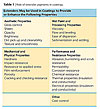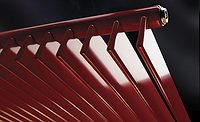

Here we discuss the use of laser diffraction for measuring the particle size of extenders. The practical relevance of this particle size data is explored with reference to the experience of Viaton Industries, the UK's largest manufacturer and processor of barium sulphate functional fillers and extenders. Viaton Industries uses a laser diffraction particle size analyzer to ensure efficient milling and one aspect of the company's work is the production of extenders used in coatings with specific gloss/gloss retention properties.
Laser Diffraction
Laser diffraction is widely used for particle size measurement in the coatings industry. Particle size is calculated from the diffraction pattern produced as light is scattered by particles in a sample, exploiting the fact that the angle and intensity of the scattered light are directly related to particle size.A laser diffraction system for laboratory use in a company like Viaton Industries must have the flexibility to handle a broad range of sample types and be able to measure across a wide size range for both wet and dry samples. Viaton Industries uses a Mastersizer 2000 (Malvern Instruments). This is a fully automated laser diffraction system driven by standard operating procedures (SOPs) that are easily developed for any given application. Measurement is fast, reproducible and robust, producing data and trend information that delivers immediate feedback for process tracking and quality control.

Extender Characterization
The use of the Mastersizer 2000 has enabled Viaton to manufacture, characterize and control the properties of super-fine powders, and to tailor the functionality of its extender products to specific applications.Barium sulphate (barytes or barite) is often used as an extender pigment in coatings systems to improve abrasion resistance and gloss retention. Viaton's Airwhite range of barium sulphate extenders is manufactured either from high-whiteness, low-silica, high-purity natural barium sulphate, or from chemically precipitated materials. Airwhite AW4C, for example, is an ultrafine, high-purity coated white extender that is used in surface coatings. In order to control the functionality of this extender, Viaton monitors the particle size reduction achieved during milling. The control point for the mill is determined by assessing the maximum particle size, as defined by the Dv97 - the particle size below which 97% of the volume of material is found. This is important because the presence of over-sized particles can affect the durability of the finished coating film and also reduce gloss. The median particle size (Dv50) is also controlled during milling, as this is important in defining how the extender and pigment particles pack together within the finished coating film. By optimizing the particle size, pigment crowding can be avoided and the optimum spacing between the pigment particles within the film can be ensured (Figure 2). This can lead to significant improvements in the opacity of the coating at a given pigment volume concentration (PVC), reducing product costs without impacting the properties of the applied film.

Extender Milling
At the start of processing, the barium sulphate extenders produced by Viaton are presented as mixtures of rocks and powder. Primary crushing reduces the large lumps to around 25 mm in size, and further processing through a roller mill takes this down to 45 - 50 microns. These particles then form the feedstock for a state-of-the-art air-jet mill. The properties of both the feedstock and product from the air-jet mill are monitored using the Mastersizer 2000 system.The material produced by the roller mill has a coarse particle size, with a large Dv97 (Figure 3). The initial parameters for operation for the air-jet mill are set according to the feedstock particle size and from historical data collected for the production of different grades of material. Once milling starts, samples are taken at regular intervals in order to monitor the size reduction process, with the target Dv97 value for Airwhite AW4C being less than 4.5 microns. This is achieved by adjusting the mill classifier speed during processing (Figure 3). Once the final product specification is confirmed, the information provided by the Mastersizer 2000 additionally acts as QC for the final product and is included on the product specification sheet.

Relating Extender Size to Gloss
As discussed, the particle size of the extender is important in controlling both gloss and gloss retention during drying of the coating film. This is illustrated in Figure 4, where the 20° gloss measured for a decorative alkyd gloss paint is shown as a function of drying time for different barium sulphate grades. The total PVC for this paint system was 21.5% (including the extender), with a primary pigment volume concentration of 2.5%.The gloss value increases significantly as the extender Dv97 decreases. This relates to improved packing of the extender particles within the paint film, leading to a more uniform surface finish. Furthermore, the rate of degradation of the gloss value over time (caused by film shrinkage during drying) is also reduced (Figure 5). This shows how important it is to consider the extender particle size as well as the pigment particle size during product development and manufacture.

Conclusions
The Mastersizer 2000 enables Viaton Industries to monitor, from start to finish, the air-jet milling process used to produce its range of extenders. The instrument's wide dynamic range is important for this application, allowing all samples to be measured accurately using the same instrumental set-up; its high resolution allows effective end-point determination, for excellent batch-to-batch reproducibility. Extender performance depends on exploiting the link between functionality (in terms of opacity, gloss and film resistance) and particle size, and the particle size data produced allow direct control of the film properties. The capacity to easily, accurately and reproducibly measure particle size plays a significant role in Viaton's ability to engineer and produce a range of extenders, each having a different particle size, for different applications.For further information, contact paul.kippax@malvern.co.uk; www.malvern.com or howardbeedle@viaton.com; www.viaton.com.


Report Abusive Comment